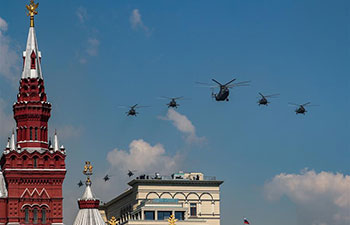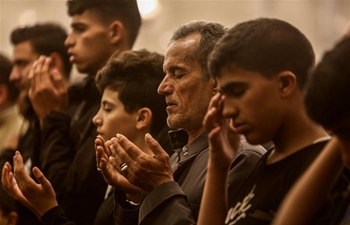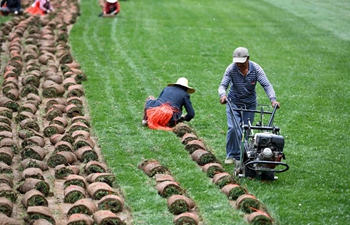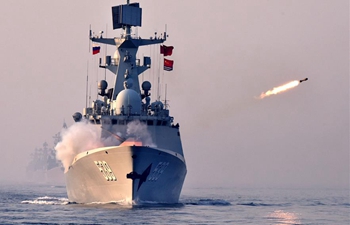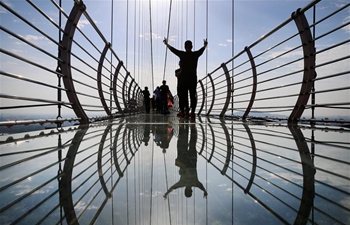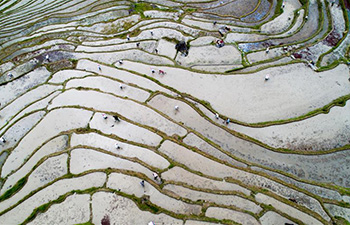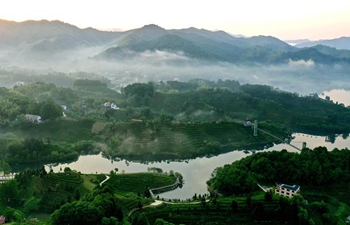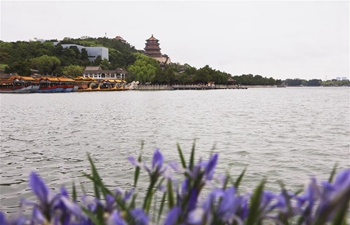
Photo taken on May 8, 2019 shows the exterior of the Administrative Office Complex of Rwanda in Kigali, capital city of Rwanda. Implemented by China's Top International Engineering Corporation, it is the largest China-aid project in Rwanda by far. (Xinhua/Lyu Tianran)
by Xinhua writer Lyu Tianran
KIGALI, May 8 (Xinhua) -- "Our aim is to deliver a high-quality aid project to the Rwandan side, promoting friendliness between the Chinese people and the Rwandan people," said Zhu Zhen, project manager of the Administrative Office Complex of Rwanda, the largest China-aid project in Rwanda by far.
Implemented by China's Top International Engineering Corporation, the project construction was commenced on July 15, 2016 and completed on Feb. 28, 2019.
It covers approximately 20,000 square meters with a total floor space of about 16,377 square meters and an eight-story main office building, including the Office of the Prime Minister as well as offices for other Rwandan ministries and commissions.
This new Administrative Office Complex will cement the good existing ties between China and Rwanda, Rwandan Prime Minister Edouard Ngirente said at the handing over and inauguration ceremony of the project on April 22.
"I would like to thank China for offering to Rwanda, such beautiful and modern office building. It will help staff of the office of the Prime Minister and those from other public institutions who will be hosted in this building, to deliver quality, fast and effective services," said Ngirente.
Zhu and his team attached great importance to the project during the construction, upholding the quality-oriented principle in every detail.
As the project manager, Zhu toured the construction site every day to check the construction quality of every corner. They also made weekly and monthly construction plans according to the progress of the project and every week reviewed the previous week's work performance.
The project team set high standards for construction materials used in the project, such as concrete. As a result, the building's concrete intensity in every part is much higher than designed intensity.
To support Rwanda's Made-in-Rwanda initiative, the project team acquired Rwanda-made products as long as they can meet the construction requirement and need.
More than 6,000 tons of Rwanda-made cement and nearly 5,000 square meters of Rwanda-made granite tiles were used in the construction.
About 260 Rwandan employees worked for the project a day at the peak. Rwandan employees of the project were taught construction skills by Chinese employees. Chinese employees at their own expenses help local employees solve difficulties of living.
"I can't hesitate to tell you that this building has high strength required. It is very good, and the materials used to build this project have high quality," said Etienne Nkurikiyimana, Building Construction Engineer at Rwanda Housing Authority and project manager on behalf of the authority.
The Chinese staff who participated in the project have high skills in construction and they are hard workers, he said, adding that the project was completed on time despite changes made in the project.
In order to deliver a good project, Zhu and his team voluntarily gave up their own benefits. In 2016, Zhu went to Rwanda to prepare the project before fully recovering from fracture and Rotator cuff rupture caused by a car accident. He never applied for returning to China for checkup, though he could, due to the busy work related to the project.
To ensure the quality of aid projects he had participated in since 2009, he gave up much of his annual leave, except when his parents passed away.
"Since we are implementing the project, we have to take the responsibility. Once I'm on leave, the whole project could be affected from operation, staff and work arrangement," he said.
"Top International Engineering Corporation paid high attention to the project and made great efforts for the project during the construction, especially project builders," said Wang Jiaxin, Economic and Commercial Counsellor of the Chinese Embassy in Rwanda.
They treated the quality as their lives, implemented the project with high standard, attached great attention to details, thus, delivering a high-quality project, he said.
